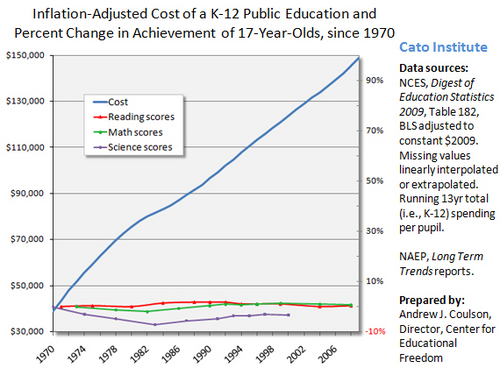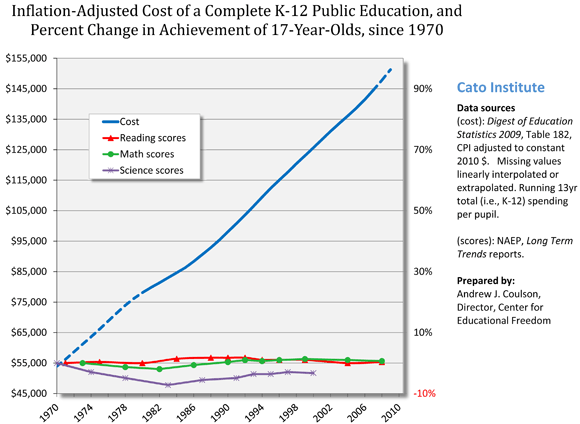UPDATE: Cost figures for the period 1970 through 1980 in the original version of chart 2, below, were inaccurate, and have been corrected in the revised version of the chart that appears below. This change does not affect the text of the article.
Teachers unions, the Obama administration, and most Democrats in Congress want to spend another $23 billion that we don’t have to shore up public school employment. If we don’t go along, they tell us, it’ll be a “catastrophe” for American education. With fewer teachers our kids will supposedly learn less, further crippling our already wounded economy.
They couldn’t be more wrong.
Over the past forty years, public school employment has risen 10 times faster than enrollment (see chart). There are only 9 percent more students today, but nearly twice as many public school employees. To prove that rolling back this relentless hiring spree by a few years would hurt student achievement, you’d have to show that all those new employees raised achievement in the first place. That would be hard to do… because it never happened.

Student achievement at the end of high school has been flat for as long as we’ve been keeping track–all the way back to 1970. But we did get something in return for all that hiring: a great, big, fat, BILL.
If you graduated from high school in 1980, your entire k-12 education cost your fellow taxpayers about $75,000, in 2009 dollars. But the graduating class of 2009 had roughly twice that amount lavished on their public school careers. The extra $75,000 we’re now spending has done wonders for public school employee union membership, dues revenue, and political clout. It’s done a whole lotta nothin’ for student learning (see chart).

But, some readers may ask: were all those new employees teachers? About two thirds of public school employment growth has been teachers (41 percent) or teachers’ aides (23 percent). The remaining third was comprised almost entirely of support staff in schools and district offices.
So, yes, a bit of public schooling’s employment bloat can be put down to a swelling bureaucracy. But given that adding a couple of million new instructional jobs did nothing to improve achievement at the end of high school, there’s no reason to expect that shedding a few hundred thousand of them would hurt it.
Ed. sec. Arne Duncan and friends are thus mistaken if they really expect a negative academic or economic impact from reversing some of our costly and ineffectual public school employment growth. In fact, they actually have it backwards.
In the private sector, jobs are created and retained only if they are believed to add value to the enterprise–if their salary and benefit costs are outweighed by the revenue they generate. By contrast, we know that the millions of new government school positions added over the past four decades have not added measurably to student knowledge or skills at the end of high school. So instead of boosting the U.S. economy, these jobs have actually been a drain on it. Returning to the staff-to-student ratio we had in 1980 would save taxpayers about $142 billion every year.
Losing a job is a terrible experience, but the school hiring binge of the past four decades has been entirely disconnected from enrollment levels and unaccompanied by educational improvement. Foolish public officials and self-serving, empire building teachers’ unions have created millions of unproductive jobs that were never justified in the first place and that have been a terrible drain on the U.S. economy. With the nation $13 trillion in debt and many state governments looking at red ink for years to come, we just can’t afford to perpetuate their mistake any longer.
Throwing billions more at the system would only worsen the problem and delay the solution, which is to help ease the transition of these workers from their current unproductive employment back into the productive sector of the economy.
COMMENTS
Please let us know if you're having issues with commenting.